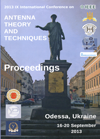Radar tomography using noise waveform, antenna with beam synthesis and MIMO principle
DOI:
https://doi.org/10.1109/ICATT.2013.6650721Keywords:
radar tomography, MIMO, SAR, noise radar, 3D imagingAbstract
Conventional SAR generates 2D image using combination of range compression and 1D aperture synthesis. Range resolution of this approach is determined by the signal spectrum width, while cross-range resolution is defined by the synthetic aperture length. 2D aperture synthesis implies movement of antenna along 2D aperture and cross-range compression technique in both dimensions to obtain resolution along two angular coordinates. In combination with pulse compression it gives 3D resolution. We suggest using MIMO principle in combination with SAR approach to generate 3D coherent radar images. For that, two linear synthetic apertures used – one for transmit antenna and another one for receive antenna. Spatial scanning with those antennas is performed in the way which provides data similar to the ones obtained from 2D scanner. The article describes the approach and presents results of its experimental test using Ka-band noise waveform ground based SAR designed in the LNDES IRE NASU.References
LUKIN, K.A. Noise Radar Technology. Telecommunications and Radio Engineering, 2001, v.55, n.12, p.8-16, doi: http://dx.doi.org/10.1615/TelecomRadEng.v55.i12.20.
LUKIN, K.A. Noise Radar Technology: the Principles and Short Overview. Applied Radio Electronics, 2005, v.4, n.1, p.4-13.
TRACHI, D.; LUKIN, K.A.; FORTUNY-GUASCH, J.; MOGYLA, A.; VYPLAVIN, P.; SIEBER, A. SAR imaging with noise radar. IEEE Trans. Aerospace Electronic Systems, 2010, v.46, n.3, p.1214-1225, doi: http://dx.doi.org/10.1109/TAES.2010.5545184.
LUKIN, K.A.; MOGYLA, A.A.; PALAMARCHUK, V.P.; VYPLAVIN, P.L.; ZEMLYANIY, O.V.; SHIYAN, Y.A.; ZAETS, M.K. Ka-band bistaic ground-based noise wavefom SAR for short-range applications. IET Proc. Radar Sonar & Navig., Aug. 2008, v.2, n.4, p.233-243, doi: http://dx.doi.org/10.1049/iet-rsn:20080017.
LUKIN, K.A.; ET AL. 2D and 3D imaging using S-band noise waveform SAR. Proc. of 3rd Int. Asia-Pacific Conf. on Synthetic Aperture Radar, APSAR, 2011, p.1-4.
LUKIN, K.A. Sliding antennas for noise waveform SAR. Applied Radio Electronics, Apr. 2005, v.4, n.1, p.103-106.

